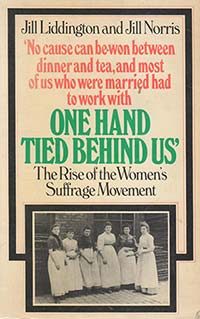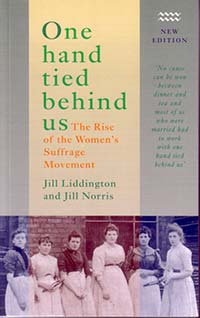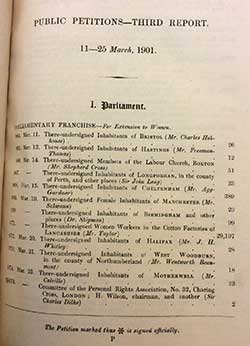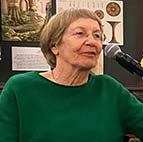

Radical suffragists
In 1974, I’d been watching BBC’s Shoulder to Shoulder, then moving up to Oldham and discovering ‘Who was Annie Kenney?’ But I soon realized that Annie had soon moved away ~ to organize in Bristol and Bath for the WSPU. (Rebecca West commented sardonically it ‘wasted a wonderful opportunity’ in despatching her south ‘to convert retired Anglo-Indian colonels’.) About Jill Liddington
So I was left wondering: who else besides the Pankhursts campaigned in the Manchester area? I soon met Jill Norris ~ who shared my sharp curiosity. We were soon on the track of other Manchester campaigners. Yet there seemed to be precious little published about the city’s amazing suffrage pioneers ~ like Esther Roper and Eva Gore-Booth. So we headed into Manchester’s magnificent Central Library archives - to find out more. What do Women do in Archives?
Esther Roper and Eva Gore-Booth
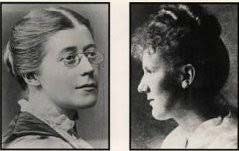 In the Archives, we soon discovered the annual reports of the North of England Society for Women’s Suffrage. Based in Manchester, the Society reached right up to the Lancashire cotton weaving towns: Preston, Blackburn, Burnley. Esther Roper was its secretary ~ and in 1902 she produced a leaflet, ‘Cotton Trade Unions and the Enfranchisement of Women’.
In the Archives, we soon discovered the annual reports of the North of England Society for Women’s Suffrage. Based in Manchester, the Society reached right up to the Lancashire cotton weaving towns: Preston, Blackburn, Burnley. Esther Roper was its secretary ~ and in 1902 she produced a leaflet, ‘Cotton Trade Unions and the Enfranchisement of Women’.
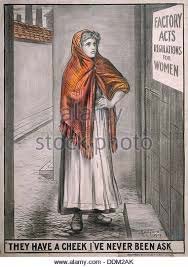 Jill and I quickly learnt we needed to head north from Manchester up to the cotton towns. Here, by 1900, no fewer than a quarter of a million women worked in the mills. In the cotton weaving towns themselves - Preston, Blackburn, Burnley - the majority of weavers were women. And they earned almost equal pay with men! They were well-organized articulate women ~ yet all remained disenfranchised.
Jill and I quickly learnt we needed to head north from Manchester up to the cotton towns. Here, by 1900, no fewer than a quarter of a million women worked in the mills. In the cotton weaving towns themselves - Preston, Blackburn, Burnley - the majority of weavers were women. And they earned almost equal pay with men! They were well-organized articulate women ~ yet all remained disenfranchised.
Esther Roper and Eva Gore-Booth seized on this anomaly. In Blackburn on May Day 1900, they launched a women textile workers’ suffrage petition. And by spring 1901, it boasted over 29,000 signatures! Fifteen women cotton workers then took the heavy roll down to Westminster. Their petition, so large it ‘looked like a garden roller’, was presented to the House of Commons. The eye-watering number of signatures totally dwarfed the other Parliamentary petitions!
Public Petitions, Lancashire Women Cotton Workers’ Suffrage petition,
March 1901 - Parliamentary Archives.
Click image to enlarge
Radical suffragists and their daughters
Jill Norris and I then had the very good fortune to be put in touch with the elderly daughters of two such women campaigners: in Nelson Selina Cooper’s daughter Mary and in Rochdale Ada Nield Chew’s daughter Doris. Oral history was then taking off. We were soon combining archival research with recording oral testimony of descendants like Mary and Doris.
In summer 1903, frustrated by the lack of suffrage progress, Esther Roper, Eva Gore-Booth, Selina Cooper and two others decided to form the Lancashire Women Textile Workers’ Representation Committee (shortly before Emmeline Pankhurst formed the WSPU).
Lancashire Women Textile Workers’ delegation to the Prime Minister, May 1906
- Lancashire Record Office. Click to enlarge
We called them the ‘radical suffragists’. They were sharply critical of Pankhurst militancy, preferring NUWSS constitutional tactics - and had a wide political agenda. Soon our ‘radical suffragist’ research was bulging into a book.
One Hand Tied Behind Us
Jill and I approached Virago Press, then a small new publisher, and were surprised and delighted when they agreed to our proposal. One Hand Tied Behind Us: the rise of the women’s suffrage movement came out in 1978.
We were fortunate that this was the time of early Women’s Liberation Movement enthusiasm. The book caused a considerable stir, garnering wonderfully enthusiastic reviews - plus some hostile criticism. It got onto history students’ reading lists and soon became a suffrage classic. At least one librarian reported it was one of her most frequently stolen books!
Some people (having watched Shoulder to Shoulder with its Pankhurst version of suffrage history) said they couldn’t quite believe One Hand. So I decided to focus on the biography of just one radical suffragist, Selina Cooper. Selina Cooper.
1980s - 2018
Tragically Jill Norris died in 1985 in an inexplicable car accident, leaving behind her partner and two younger daughters.
Yet her work lives on. Virago had produced a second edition in 1984; eventually a third edition was published in 2000 (Rivers Oram Press) for which I wrote a substantial new Introduction, reflecting back ‘Women’s Suffrage Twenty-one Years On’.
Finally, and long while after, I met French historian Fabrice Bensimon who was taking his lucky Sorbonne students on a radical history tour of the north. And I was delighted when he suggested a French edition of One Hand. Histoire des Suffragistes Radicales is published by Editions Libertalia in Paris on International Women’s Day, March 2018.
